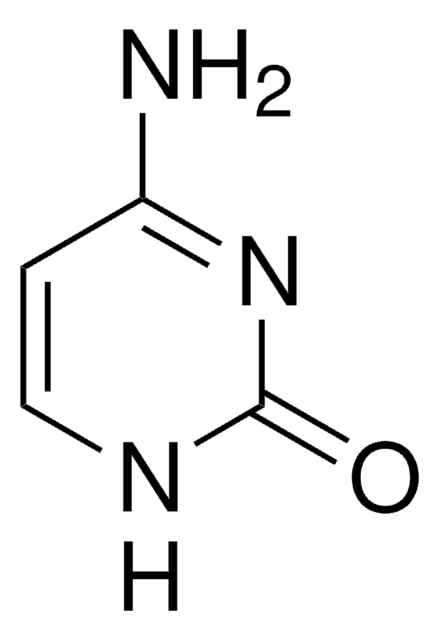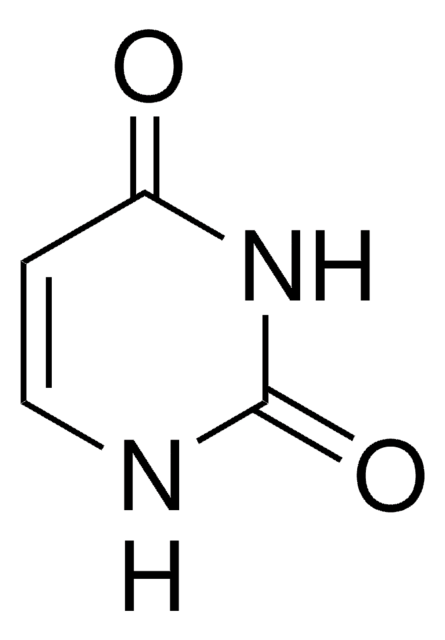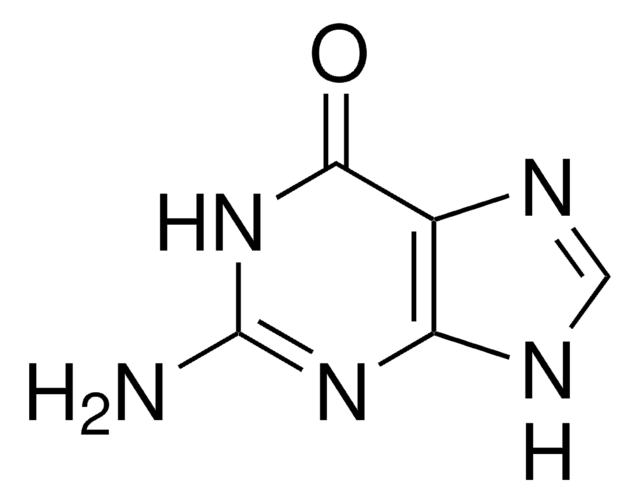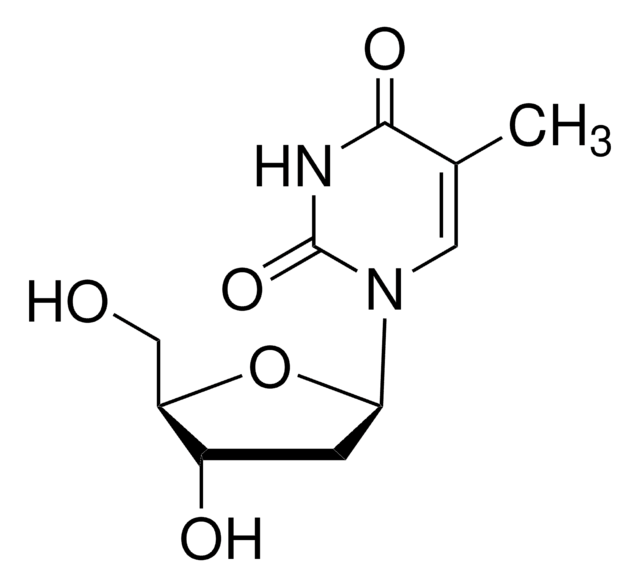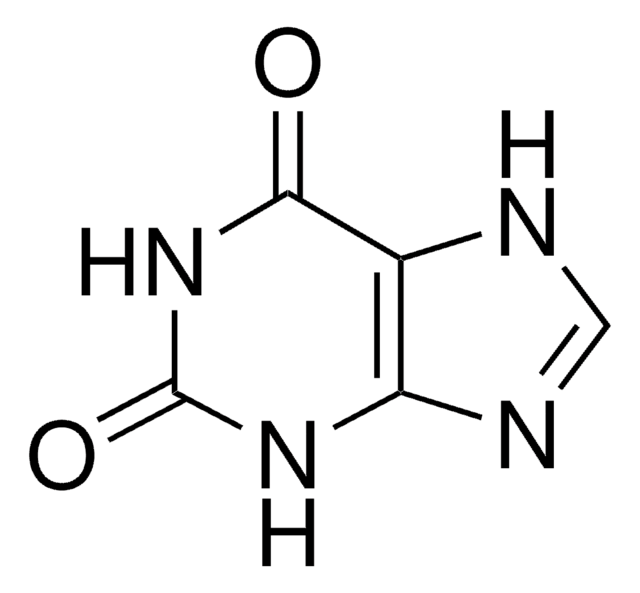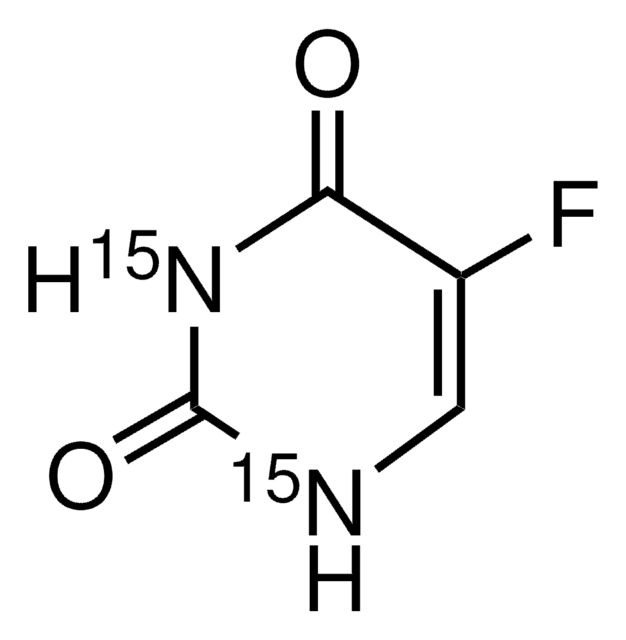T0376
Thymine
≥99%
Sinonimo/i:
2,4-Dihydroxy-5-methylpyrimidine, 5-Methyluracil
Autenticatiper visualizzare i prezzi riservati alla tua organizzazione & contrattuali
About This Item
Formula empirica (notazione di Hill):
C5H6N2O2
Numero CAS:
Peso molecolare:
126.11
Beilstein:
117880
Numero CE:
Numero MDL:
Codice UNSPSC:
41106305
ID PubChem:
NACRES:
NA.51
Prodotti consigliati
Origine biologica
synthetic (organic)
Livello qualitativo
Saggio
≥99%
Stato
powder
Punto di fusione
~320 °C (dec.) (lit.)
Stringa SMILE
CC1=CNC(=O)NC1=O
InChI
1S/C5H6N2O2/c1-3-2-6-5(9)7-4(3)8/h2H,1H3,(H2,6,7,8,9)
RWQNBRDOKXIBIV-UHFFFAOYSA-N
Informazioni sul gene
mouse ... Tymp(72962)
Cerchi prodotti simili? Visita Guida al confronto tra prodotti
Descrizione generale
Thymine is one of the four nucleobases, along with adenine, guanine and cytosine found in deoxyribonucleic acids (DNA).
Applicazioni
Thymine has been used as a standard nitrogenous base in high-performance liquid chromatography-ultraviolet (HPLC-UV) for the quantification of bone DNA samples, Raman scattering experiments. It has also been used as supplement in C2C12 myoblast cells. Thymine may be used to study chemical processes that affect DNA structure, such a radiation induced radical production leading to base cross-linking reactions and derivitizations. It may be used to study the parameters of hydrogen bonding kinetics and energies with other nucleobases such as adenine.Thymine is used to develop sensitive heavy metal (mercury) detectors based on coordination chemistry and nanoparticle structures.
Azioni biochim/fisiol
Thymine used in studying DNA structure byirradtaion methods leading to cross-linking reactions and derivitizations. Thymine dimers are indicative of DNA damage. Thymine is used with metal (mercury) to form thymine−HgII−thymine (T−HgII−T) duplexes. Thymine starvation in bacteria leads to halt in DNA synthesis and is referred as thymine-less death.
Codice della classe di stoccaggio
11 - Combustible Solids
Classe di pericolosità dell'acqua (WGK)
WGK 3
Punto d’infiammabilità (°F)
Not applicable
Punto d’infiammabilità (°C)
Not applicable
Dispositivi di protezione individuale
Eyeshields, Gloves, type N95 (US)
Scegli una delle versioni più recenti:
Possiedi già questo prodotto?
I documenti relativi ai prodotti acquistati recentemente sono disponibili nell’Archivio dei documenti.
I clienti hanno visto anche
Methods for detection of cytosine and thymine modifications in DNA
Berney M and McGouran JF
Nature Reviews Chemistry, 1-1 (2018)
On How Watson and Crick Discovered what Watson and Crick had Suggested: The" Folk" Concept of Discovery Rediscovered
Charpa U
History and philosophy of the life sciences, 7-30 (2008)
Andrej Dementjev et al.
Scientific reports, 10(1), 17097-17097 (2020-10-15)
Identification of chemically homologous microcrystals in a polycrystal sample is a big challenge and requires developing specific highly sensitive tools. Second harmonic (SHG) and coherent anti-Stokes Raman scattering (CARS) spectroscopy can be used to reveal arrangement of thymine molecules, one
MercuryII-mediated formation of thymine- HgII- thymine base pairs in DNA duplexes
Miyake Y, et al.
Journal of the American Chemical Society, 128(7), 2172-2173 (2006)
Yang-Wei Lin et al.
The Analyst, 136(5), 863-871 (2010-12-16)
Monitoring the levels of potentially toxic metal (PTM) ions (e.g., Hg(2+), Pb(2+), Cu(2+)) in aquatic ecosystems is important because these ions can have severe effects on human health and the environment. Gold (Au) nanomaterials are attractive sensing materials because of
Il team dei nostri ricercatori vanta grande esperienza in tutte le aree della ricerca quali Life Science, scienza dei materiali, sintesi chimica, cromatografia, discipline analitiche, ecc..
Contatta l'Assistenza Tecnica.